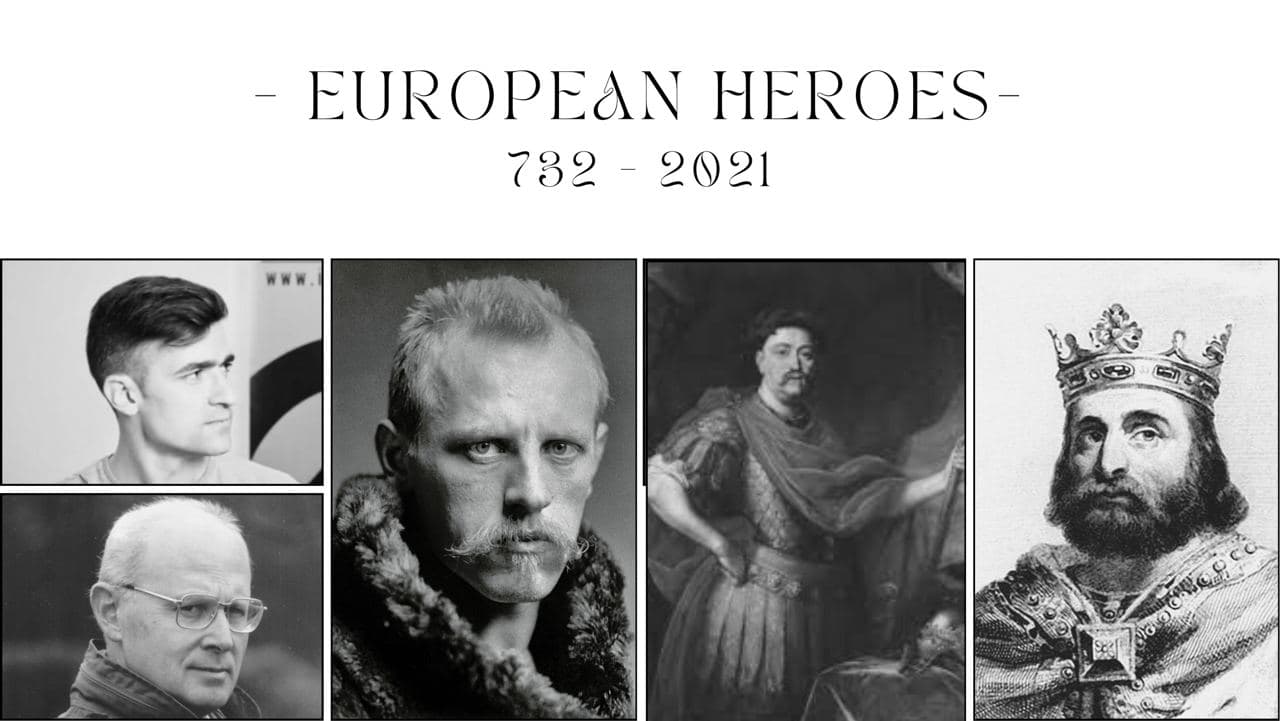On the first page of “Defenders of The Golden Apple” the readers are greeted with an illustration of five men and the following text:
“Dedicated to the heroic men and women who defended the apple three, from ancient times to our struggle of today.”
An observant reader that is acquainted with European history and modern day right wing politics might recognise some or all of the personalities we choose to exemplify these heroes.
Starting by one representative that lives today and going back in time we are happy with the five that we ended up with.
European heroes
Martin Sellner
Austrian-born Sellner (January 8. 1989– ) might be the most effective and inspirational pan-european activist alive today. In his role as one of the leaders of Generation Identity (Identitäre Bewegung) he has led a series of non-violent actions against islamisation, The Great Replacement and multiculturalism in multiple countries in Europe.
The most noteworthy would be the successful “Defend Europe – Mediterranean” campaign where Generation Identity chartered a ship to expose the collaboration between human traffickers and pro-migration non-governmental organisations (NGOs).
In addition to Greenpeace inspired activism, Sellner is also a published author and the founder of the clothing brand Phalanx-Europa.
Like Dominique Venner, Sellner considers the struggle for European self determination and ethnocultural identity to be of a metapolitical character.
Dominique Venner (1935–2013)
Dominique Venner was born in Paris on April 16, 1935. He was a prominent historian and author associated with the French “New Right” (Nouvelle Droite) and ran the history magazine La Nouvelle Revue d’Historie.
He published a number of books that have been translated into English, German, Spanish, Portuguese and Italian, among others.
On the 21st of May in 2013, Venner committed suicide in the cathedral of Notre Dame de Paris in a last defiant act to awaken the French people.
In his last blog post, published a few hours before the suicide, Venner urged the participants in a forthcoming demonstration against the new same-sex marriage law not to ignore the ongoing demographic change in France. He believed that their struggle should not be limited to opposition to gay marriage, but that they should also fight the Great Replacement, or face a catastrophic risk to the future.
Fridtjof Nansen (1861–1930)
Fridtjof Nansen (10. October 1861–13. May 1930) was a Norwegian Nobel Peace Prize laureate and polymath. He held strong anti-communist and ethnopluralist beliefs and is known as an explorer, scientist, diplomat and humanitarian.
He led the team that made the first crossing of the Greenland interior in 1888, traversing the island on cross-country skis. He won international fame after reaching a record northern latitude of 86°14′ during his Fram expedition of 1893– 1896.
During the Russian famine in 1921–1922, Nansen organised aid to 32 million people in Russia, Ukraine and Georgia who were threatened with starvation. For his humanitarian and peace-building work, Nansen received the Nobel Peace Prize in 1922.
After the Greco-Turkish War of 1919–1922, Nansen devised a framework for a population exchange whereby half a million Turks in Greece were returned to Turkey, with full financial compensation, while further loans facilitated the absorption of the refugee Greeks into their homeland.
From 1925 onwards, Nansen devoted much time helping Armenian refugees, victims of the Armenian genocide.
In 1925 Nansen co-funded the Fatherland League (Fedrelandslaget), an anti-communist organisation in Norway. In 1929 Nansen went on his final tour for the Fatherland League on the ship Stella Polaris, holding speeches from Bergen to Hammerfest.
John III Sobieski (1629–1696)
John III Sobieski (17. August 1629–17. June 1696) was King of Poland and Grand Duke of Lithuania from 1674 until his death. Sobieski demonstrated his military prowess during the war against the Ottoman Empire and established himself as a leading figure in Poland and Lithuania. In 1674, he was elected monarch of the Polish–Lithuanian Commonwealth.
At The Battle of Vienna in 1683, Sobieski personally led the charge ahead of 3,000 Polish horsemen, the now famous Winged Hussars.
For his role in the battle, A constellation was named after Sobieski; Scutum Sobiescianum (Shield of Sobieski), to commemorate the victory of the Christian forces.
He was also granted the title of “Defender of the Faith” (“Defensor Fidei”) by Pope Innocent XI.
Karl Martel (686–741)
Karl Martel was born in Herstal in what is now Wallonia in Belgium as the son of the Frankish statesman, Pipin of Herstal.
He is best known for his victory in the Battle of Poitiers in 732 AD, in which he stopped a Moorish invasion led by the Islamic governor of al-Andalus: Muslim-ruled Iberia. With this victory he put an end to further Muslim conquest in France.
Martell’s Franks, whose infantry were almost entirely unarmoured, managed to resist armoured horse riders that were also numerically superior, without the help of bows or firearms, a feat that is perhaps unparalleled in medieval history.
After his victory at Poitiers, Martell continued to beat back Muslim armies from bases in Gaul during his campaigns in 736 and 737 after they again tried to gain a foothold in Europe.
On October 20, 2012, Generation Identity (Generation Identitaire) in France demonstrated on top of the roof of a mosque under construction in Poitiers to commemorate the battle and protest the Islamisation of France.

